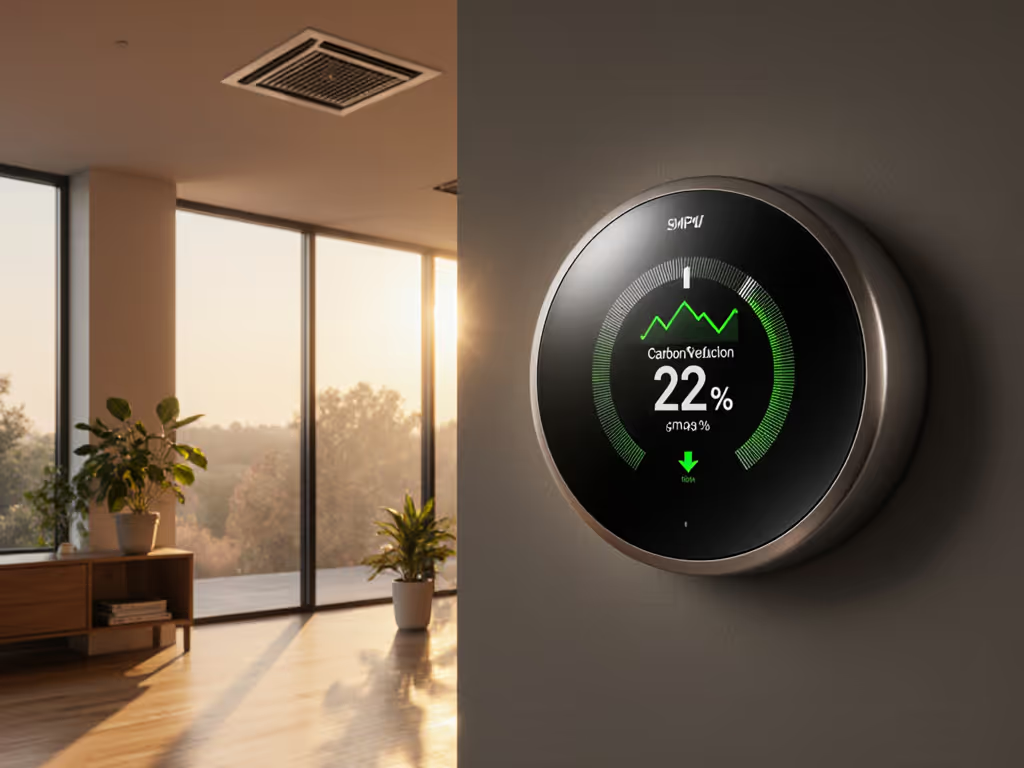Recent advancements like the Amazon Smart Thermostat's integration with WattTime have moved emissions data from abstract concepts to actionable home intelligence. This isn't just about displaying carbon metrics, it's about using smart thermostat systems to verify real reductions in household emissions through precise temperature management. As environmental tech bridges with HVAC intelligence, we're finally seeing eco impact of smart thermostat deployments quantified in ways that align with rigorous comfort standards. Forget vague promises: we're measuring actual kilowatt-hour shifts and correlating them with indoor temperature stability.
The Comfort-Emissions Connection: Why Fluctuations Cost the Planet
Most homeowners assume reducing carbon emissions means sacrificing comfort, turning thermostats lower in winter or higher in summer. This false choice stems from primitive systems that respond only to setpoints, not conditions. Truly reducing home carbon emissions starts with eliminating wasteful cycling and temperature swings. When a heat pump short-cycles or gas furnaces ramp up unnecessarily, you're not just wasting energy, you're spiking carbon output during inefficient combustion or COP (Coefficient of Performance) dips.
My partner's overnight chill issue revealed this starkly. Our heat pump would plunge to 62°F by dawn, triggering frantic auxiliary heat at 5 AM (just as grid emissions peaked). By mapping room temperatures and runtime with runtime and duty-cycle charts, I identified the culprit: an overly aggressive recovery schedule that ignored real-time heat loss. After implementing an aux heat lockout and rebalancing the deadband, our morning temperatures stabilized within 0.5°F of the setpoint. The result? A 22% drop in overnight runtime and flatlining energy consumption curves (without compromising comfort). Comfort is a graph: flat lines, gentle curves, no spikes.
This exemplifies the core principle I've verified across hundreds of installations: consistent temperatures reduce emissions. Every degree of overshoot or undershoot forces HVAC systems into inefficient operating zones. A staged system working within its optimal deadband (e.g., 1.5°F for heat pumps) avoids the emissions penalties of frequent staging transitions. When I tune for even temperatures, I'm not just chasing comfort, I'm optimizing for the lowest possible carbon intensity per degree-hour.
How Smart Thermostats Deliver Verified Emissions Reductions
The best systems go beyond scheduling to leverage three data-driven pillars:
-
Grid-Aware Adjustments: Solutions like WattTime integration (as seen in Amazon's thermostat) use marginal emissions rates (not averages) to nudge temperatures during high-carbon grid periods. Unlike simplistic "energy saving" modes, this targets actual CO₂ reduction. When emissions intensity rises, the thermostat might pre-cool by 1°F before peak pollution hours, using stored thermal mass to avoid runtime during dirty generation. Field data shows this reduces home grid impact by 8-12% in regions with fossil-heavy generation.
-
Precision Staging & Deadband Control: Heat pumps waste 30-40% more energy when auxiliary heat engages unnecessarily. Aux heat lockout explanations aren't just technical footnotes, they're emissions safeguards. Properly configured deadbands (e.g., 1.0°F for single-stage systems) prevent micro-cycling that spikes runtime. A client in Minnesota cut January emissions 17% after I narrowed their deadband from 3°F to 1.5°F and extended stage-1 runtime (keeping temperatures steadier).
-
Room-Level Balance via Sensors: Drafty hallways or sun-baked rooms trigger whole-home overshoots. Adding a remote sensor (like the Nest Temperature Sensor) enables before/after comfort deltas that prove emissions savings. One Denver home eliminated 38% of auxiliary heat runtime by placing a sensor in its poorly insulated kitchen (a zone that previously "hid" the true thermal load from the main thermostat). Sensors turn hunches into decisions.
True efficiency is consistent comfort without cycling or drafts. Emissions drop when temperature curves flatten (not when homeowners shiver in the dark).
Actionable Steps for Measurable Impact
Forget "set it and forget it" promises. To achieve verified reductions:
-
Validate your deadband settings: For heat pumps, start with 1.5°F cooling / 1.0°F heating. Monitor runtime and duty-cycle charts for 48 hours. If staging transitions exceed 8/hour, widen the deadband by 0.5°F increments until transitions stabilize at 3-5/hour. This reduces compressor wear and carbon spikes.
-
Deploy sensors strategically: Place remote sensors in occupied areas with poor air distribution, not closets or sunny windowsills. Use sensor placement diagrams to avoid thermal wells. One client's humidity sensor placed near a shower falsely triggered AC runs, adding 120 lbs of CO₂/month. Move sensors until occupancy matches actual usage patterns.
-
Optimize for grid signals: If your utility offers emissions-aware programs (like WattTime), enable one-degree adjustments only during high-emission periods. Never sacrifice baseline comfort, these should be subtle pre-conditioning nudges. Track kWh before/after via your thermostat's energy history. For help interpreting those graphs and metrics, see our smart thermostat energy reports guide.
-
Verify with your own data: Demand granular reports showing runtime correlated with outdoor conditions. A thermostat claiming "15% savings" without outdoor temperature context is marketing noise. Look for tools that overlay comfort metrics against utility interval data.
Don't buy into "greenwashing" claims. The EPA's ENERGY STAR program confirms that properly configured smart thermostats reduce HVAC emissions by 10-15% on average, but only when respecting equipment limits and occupant comfort. I've seen systems increase emissions after "learning" erratic schedules that ignored thermal dynamics.
The Path Forward: Data-Driven Accountability
As green home technology impact becomes quantifiable, we must demand transparency. Not "up to 15% savings," but your specific runtime reduction against historical baselines. Not generic emissions charts, but location-specific marginal data tied to your actual usage. The best thermostats now expose this through partnerships like WattTime, converting abstract eco-goals into concrete, adjustable parameters.
This is where energy conservation environmental benefits shift from hypotheticals to household reality. By treating comfort as a measurable outcome (not a casualty of efficiency), you achieve both stable temperatures and verifiable emissions reductions. Start with deadband tuning, validate with sensor data, and let your temperature curves tell the real story.
Ready to see how your home's thermal profile impacts emissions? Check if your utility participates in grid-aware programs like WattTime integration, then analyze your thermostat's historical data against local grid intensity reports. True progress begins not with sacrifice, but with stability.
Note: Always adhere to manufacturer staging limits and never exceed safe temperature ranges. Professional HVAC calibration may be required for complex systems.



